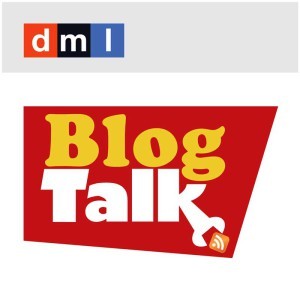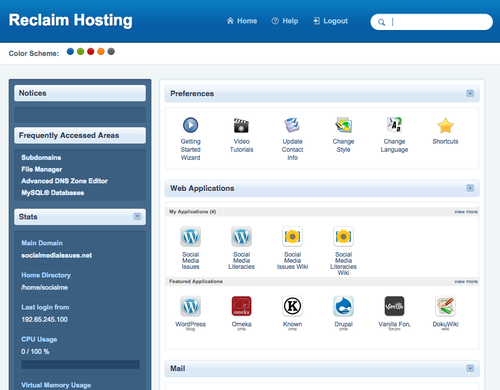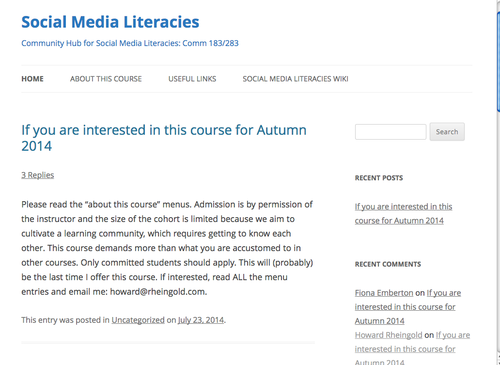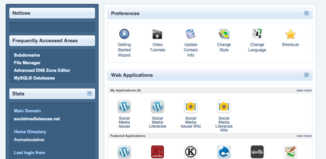Syndicated
Under The Hood: Where Technology, Pedagogy, and Power Meet


Image: http://www.bighappyfunhouse.com/archives/here_look_under_the_hood.jpg
This week’s “pre-course” unit is about digging more deeply into WordPress as a platform for open, connected courses — and about exploring the cPanel that enables domain of one’s own participants (and people who access similar platforms from other providers) to install WordPress, MediaWiki, Discourse, and other applications/media on servers that they can control. I’ve been through the process of moving from blogger to blog publisher to media platform tinkerer myself, and I’m still somewhat in the novice camp. Fortunately, this unit’s co-facilitators, Jim Groom and Alan Levine, are experts, to say the least. In this week’s Blogtalk (2 PM Pacific, Friday, September12), I’ll be looking under the hood with them.
Why go through the bother of installing and configuring WordPress or MediaWiki, Disqus or Discourse or Etherpad or all of the above? To me, it’s magic. For practically nothing — $25/year — I can create a co-learning environment for a seminar of 25 or a MOOC of thousands. Blogs, comments, forums, collaborative documents. The technologies of publishing and discourse that become available to those who are willing to look under the hood and try some tinkering can be used as powerful amplifiers of co-learning. The objective is not to teach mastery of web media, but to make it easier for students to take responsibility for their own learning and enough co-responsibility for their classmates’ learning that a real learning community can emerge.

Mastering these tools is a means to an end for educators, but learning such mastery involves a meta-skill for educators and co-learners alike — in an era of inexpensive or free web apps, open educational resources, and increasingly experienced peer-learners, knowing how to roll your own learning community infrastructure is becoming essential.
I’ve been messing with social media learning platforms for about ten years, and thinking about them even longer. In 1995, I designed a demo of a “university of the future” for the NEC corporation — they built a working version at the cost that probably ran into millions of dollars. Here is what the mockup of the student profile page looked like (remember — 1995 broadband was the 22,500 baud modem):

When I started teaching about social media at Berkeley and Stanford, I grew aware of the limitations of learning management systems, even the open source ones such as Sakai and Moodle, when it came to the affordances for social media — blogs, forums, wikis. So I used a wiki from one source, a forum from another vendor, and yet a third platform for blogs. My students complained that not only were they climbing the learning curve of these media, but each one had a different log in and interface. So I entered HASTAC’s Digital Media and Learning competition and from the most award I hired a developer, Sam Rose, to create an integrated social media learning environment based on Drupal. We called it the Social Media Classroom and I used it for years. I still use it for my Rheingold U courses. Learners can log in once and switch from wiki to forum to blog to social bookmark by clicking on different tabs in the same browser window.

Then my curiosity about all the action around the mysterious hashtag #ds106 led me to discover what Jim Groom, Alan Levine, Martha Burtis and Tim Owen were doing with WordPress and open learning at the University of Mary Washington. In three one-hour sessions (which we recorded: the first, the second, the third), Groom showed me how to set up a domain of my own, operate cPanel, install and configure WordPress and set it up as a class hub. Using WordPress pages and menus, easily accessible from the dashboard, I added a MediaWiki, a series of syllabus pages, and a Discourse forum (now I start with a Facebook group). We use the blogs for individual voice and conversation about texts and the forum or Facebook group for group voice about overarching issues that emerge from the text. And each student claims a domain and installs their own WordPress blog.
My co-learners and I learn about social media, the subject of the course, and we also learn about how to make our own social media learning environments. Knowing web publishing doesn’t just confer a mighty learning power — it’s about the power to persuade, inform, and organize that is now available to more than a tiny elite, but only to those who are willing to experiment, tinker, and learn.

Under The Hood: Where Technology, Pedagogy, and Power Meet
@drjackson My friend @ann_steckel asked me if #ccourses was what you are working with. Our avatars met in Second Life years ago.
— Liz Dorland=Chimera Cosmos in Second Life (@ldinstl_chimera) September 10, 2014
— Susan J Roll (@SusanSocialWork) September 10, 2014
Under The Hood: Where Technology, Pedagogy, and Power Meet http://t.co/ex40fUNu5C good stuff in one week from #ccourses than 4 a long time.
— Papahazama (@papahazama) September 10, 2014
Getting Moved In
Brazil status quo CCourses #MetaMOOCProject @Bali_Maha #Rhizo14 #ccourses http://t.co/F6Cy98EkUb
— Paulo Batista (@paulormbatista) September 10, 2014
CogDogBlogged: Seeking Syndicated / Distributed / Connected Course Examples http://t.co/A6DZoTOIvT #ccourses
— Alan has x-ed to @cogdog@cosocial.ca (@cogdog) September 10, 2014
Maha Bali project and post about Meta-Mooc Project Proposal for #ccourses allowed me to reflect… http://t.co/mgoLY6YbqM
— Paulo Batista (@paulormbatista) September 10, 2014
I acknowledge my old blog http://t.co/9FIqmmfCSh needs a facelift and simpler interface. Help! @cogdog @hrheingold @jimgroom #ccourses
— Jeffrey Keefer (@JeffreyKeefer) September 10, 2014
Only the Beginning…
I finally connected my blog to #ccourses though am not sure my feed to the tag alone works. I tried to confirm, but . . .
— Jeffrey Keefer (@JeffreyKeefer) September 10, 2014
@drjaxon Wow, that is impressive work for building a #ccourses like blog hub. I will see if I can generalize code for blog list to plugin
— Alan has x-ed to @cogdog@cosocial.ca (@cogdog) September 10, 2014


